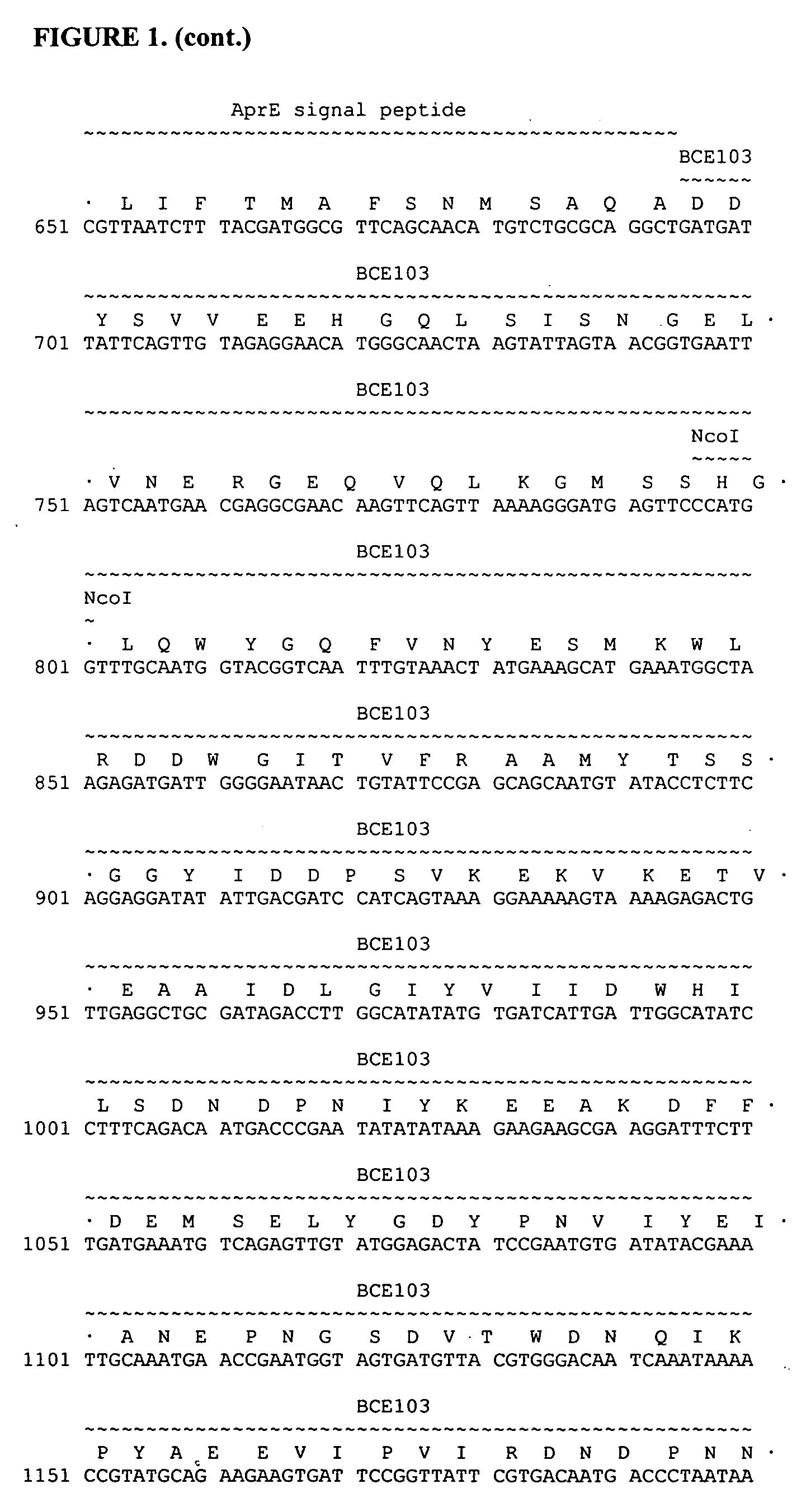Bacterial expression of protease inhibitors and variants thereof
a protease inhibitor and bacterial technology, applied in the field of protease inhibitor expression and variants, can solve the problems of inability to isolate the natural protease inhibitor for clinical applications, the imbalance between protease and protease inhibitors is often associated with pathologic tissue destruction, and the protease inhibitor interferes with the action of proteases, so as to reduce disulfide bonds and alter the redox potential
- Summary
- Abstract
- Description
- Claims
- Application Information
AI Technical Summary
Benefits of technology
Problems solved by technology
Method used
Image
Examples
example 1
Production of BCE103-BBI Fusion Proteins in B. subtilis
[0131] In this Example, experiments conducted to produce BCE103-BBI fusion proteins in B. subtilis are described. The DNA sequence of the synthetic gene (Operon Technologies) coding for the pro-BBI protein with a C-terminal hexa-histidine tag used in these experiments is:
(SEQ ID NO:10)AACCTGCGTCTGTCTAAGCTTGGCCTGCTTATGAAATCAGACCATCAGCACAGCAATGACGATGAGAGCTCTAAACCCTGTTGCGATCAATGCGCATGTACGAAATCAAATCCTCCACAGTGTCGGTGTTCCGATATGCGTCTGAATAGCTGTCATAGTGCATGCAAAAGCTGTATCTGCGCCCTGAGTTATCCAGCTCAATGTTTTTGCGTCGACATCACGGACTTCTGCTATGAGCCATGTAAACCAAGCGAGGACGATAAAGAGAACCATCATCACCATCACCAT
[0132] The protein sequence of pro-BBI with a C-terminal hexa-histidine tagged coded for by the above synthetic gene is:
(SEQ ID NO:11)NLRLSKLGLLMKSDHQHSNDDESSKPCCDQCACTKSNPPQCRCSDMRLNSCHSACKSCICALSYPAQCFCVDITDFCYEPCKPSEDDKENHHHHHH
[0133] The portion of the DNA sequence of the synthetic gene that codes for the major mature form of BBI is:
(SEQ ID NO:12)GACGATGAG...
example 2
Production of Peptides Substituted into the BBI Reactive Site Loops as BCE103-BBI Fusion Proteins
[0146] In this Example, experiments conducted to produce peptides substituted into the BBI reactive site loops as BCE103-BBI fusion proteins are described. The primers, as well as other sequences used in the various steps of these experiments are provided below. The sequence of 12BBIck81 from the BCE103 fusion site (at the BamHII) to the end of the gene is provided in FIG. 3. The CK37281 peptide sequences (ACYNLYGWTC (SEQ ID NO:9) are inserted into both the trypsin and chymotrypsin inhibitory loops.
[0147] The primers used to introduce an EcoRI site in the BBI gene using QuikChange® site-directed mutagenesis (Stratagene) were:
BowBeco-F5′-GATATGCGTCTGAATTCCTGTCATAGTGCAT(SEQ ID NO:17)BowBeco-R5′-ATGCACTATGACAGGAATTCAGACGCATATC(SEQ ID NO:18)
[0148] The sequences of the DNA oligonucleotides that were annealed and cloned in the BBI gene (SacI-EcoRI) to replace the trypsin inhibitory loop wi...
example 3
Activation of BBI by Thiol Reducing / Oxidizing Agents
[0164] After growth, the activity of the BBI (by trysin or chymotrypsin inhibition) is typically some 5-20 times lower than what would be expected from the activity of the BCE103 cellulase measured in the cell free supernatants (the two molecules should be present at a 1:1 molar ratio in the fusion protein). An increase in the activity of BBI (measured by either trypsin or chymotrypsin inhibition) in the BCE103-BBI fusion protein can be routinely obtained by adding bME, typically concentrations of 1-4 mM added to the MBD growth medium about 14 h after inoculation. The trypsin or chymotrypsin inhibitory activity of BBI in the fusion protein is also lower than expected when binding peptides (e.g. VegF binding peptide CK37281) replace the chymotrypsin or trypsin reactive site loop, respectively. As with the wild-type BBI, the inhibitory activity can be increased by treatment with bME. Unexpectedly, other thiol reducing agents (e.g., ...
PUM
| Property | Measurement | Unit |
|---|---|---|
| temperature | aaaaa | aaaaa |
| temperature | aaaaa | aaaaa |
| temperature | aaaaa | aaaaa |
Abstract
Description
Claims
Application Information
 Login to View More
Login to View More - R&D
- Intellectual Property
- Life Sciences
- Materials
- Tech Scout
- Unparalleled Data Quality
- Higher Quality Content
- 60% Fewer Hallucinations
Browse by: Latest US Patents, China's latest patents, Technical Efficacy Thesaurus, Application Domain, Technology Topic, Popular Technical Reports.
© 2025 PatSnap. All rights reserved.Legal|Privacy policy|Modern Slavery Act Transparency Statement|Sitemap|About US| Contact US: help@patsnap.com



